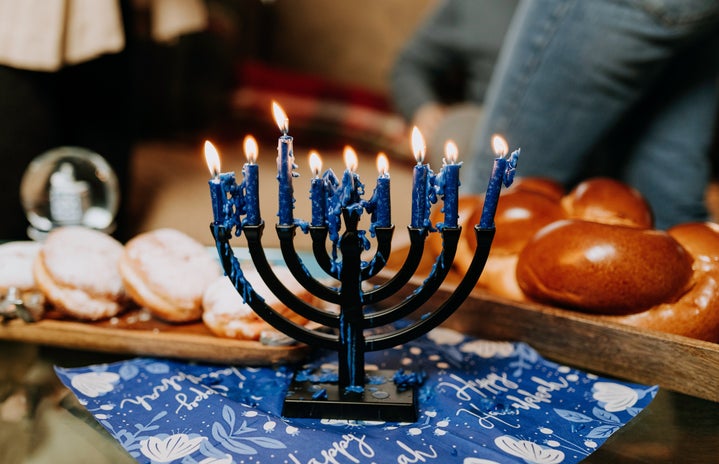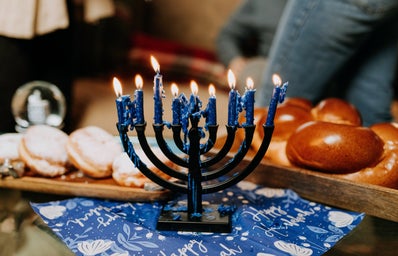Growing up, my favorite holiday to celebrate with my family was Hanukkah. While at first, this was simply because I loved receiving presents and decorating my house in blue and white, I soon began to love the holiday for its cultural significance to the Jewish community. But what is the significance of Hanukkah? Although it may seem surprising, Hanukkah, also known as “the Festival of Lights,” is not considered a major holiday in the Jewish faith. So why is it such a popular holiday for so many Jewish people to celebrate, regardless of their level of observance?
The best way to explain the importance of this holiday would be by giving the background of the holiday’s history first and then expounding on its important traditions and customs.
In the second century B.C.E., the land of Judea was under Greek-Syrian occupation. The ruler of the empire at that time, Antiochus IV, forbade Jewish people from practicing Judaism and forcefully assimilated them into Hellenistic pagan culture. After Antiochus and his soldiers ravaged Jerusalem and the Second Holy Temple, Judah Macabee led a rebellion of Jews against Antiochus IV and by a miracle, succeeded.
When it was decided to rebuild the Holy Temple, the Jewish people realized that there was only enough oil to light the Temple’s menorah for one day. However, the oil was able to last eight days, just enough time for the Jewish people to retrieve more oil for the menorah. Both the reclaiming of Jerusalem from the Greek-Syrian Empire and the burning of the oil for eight days are miracles commemorated by Hanukkah.
So how exactly do we commemorate these miracles?
The Menorah (Hanukiah): What is it and why do we light it?
A menorah is a candelabra that holds seven candles and was used in the Holy Temple in Jerusalem. Menorahs can be found today in synagogues across the world. A Hanukiah is a menorah that has eight branches and a “shamash,” or a candle that lights the other eight candles, and is only used on Hanukkah. On each of the eight nights of Hanukkah, it is customary to light the candles on the Hanukiah, starting with one candle, and then lighting an extra candle every night until all eight branches are lit. This is to remember how the oil for the menorah in the Second Holy Temple lasted for eight days instead of one.
Personally, my favorite part about the tradition of the lighting of the Hanukiah is how you place it in your window, or outside your house, as a way to ‘publicize’ the miracle that God provided for the Jewish people. By placing menorahs in public view, Jewish people show others that they are proudly embracing their culture and heritage, an action they could not do under Antiochus’ rule. I always found this to be the most beautiful aspect of Hanukkah, as it taught me how to embrace and be proud of my culture. The Hanukiah, in my understanding, represents the perseverance and the strength of Jewish people. That the light of Jewish people cannot be simply snuffed out.
The Dreidel: Why do we play this game on Hanukkah?
A dreidel is a spinning top with four sides, with a different Hebrew letter on each side. When the Greek-Syrians ruled over Judea, outlawing the practice of Judaism, Jewish people would hide in caves to learn the Torah. If Jewish people saw a soldier coming towards them, they would take out dreidels to hide the fact that they were studying the Torah. Today, this game is usually played with gelt (chocolate coins), in which the goal (at least how my family plays it) is to take as much gelt from the center ‘pot’ as possible.
While I always loved to play this game with my siblings growing up, I began to appreciate it more knowing the context for why we play it. Dreidels were a way for the Jewish people to be able to continue practicing their religion, even under an oppressive regime. This game resembles the Jewish people’s persistence in keeping their practices alive.
The Food: Why is everything fried?
Like with any Jewish holiday, food is a major component in observing Hanukkah. A common tradition is to eat foods that are fried in oil. But why? As mentioned before, one of the two miracles of Hanukkah was that the oil for the Menorah in the Holy Temple lasted eight days instead of one. So of course, the most popular Hanukkah foods are the ones that are fried in oil.
Two of the most popular foods to eat on Hanukkah are Latkes and Sufganiyot.
Latkes are fried potato pancakes usually eaten with applesauce and sour cream. While my grandpa doesn’t have an exact recipe, he uses just a few simple ingredients: potatoes, matzah meal, onions, eggs, salt, and pepper. On Hanukkah, I will always be found with a Latke in hand.
Sufganiyot are jelly-filled doughnuts (fried in oil, of course) that Jewish people around the world eat on Hanukkah. While Sufganiyot are usually jelly-filled, it is not the only flavor people eat. My family usually takes a trip to our local kosher bakery to pick up freshly baked doughnuts for the first night of Hanukkah.
While Hanukkah is to commemorate God’s two miracles during the time of the Second Holy Temple, it is also a constant reminder of the importance of preserving the Jewish culture and promoting the right of Jewish existence. Jewish people use Hanukkah as a symbol of the preservation of a culture thousands of years old that has been time and time again the victim of persecution. In difficult times, Jewish people around the world should decorate their houses this Hanukkah, put up lights, light the Hanukiah, and use this eight-day holiday to embrace their Jewishness. Being proud of our culture and celebrating it is one of the most important things we can do to ensure that the light of the Jewish people cannot be extinguished by hatred.
Sources:


